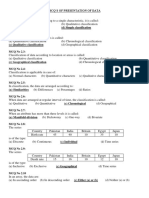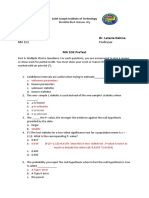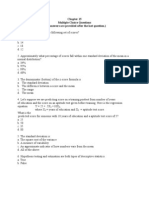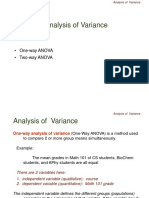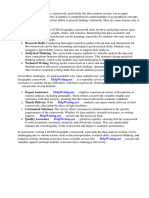MCQ Regression and Correlation With Correct Answers 1
MCQ Regression and Correlation With Correct Answers 1
Uploaded by
Ankit SinghCopyright:
Available Formats
MCQ Regression and Correlation With Correct Answers 1
MCQ Regression and Correlation With Correct Answers 1
Uploaded by
Ankit SinghOriginal Title
Copyright
Available Formats
Share this document
Did you find this document useful?
Is this content inappropriate?
Copyright:
Available Formats
MCQ Regression and Correlation With Correct Answers 1
MCQ Regression and Correlation With Correct Answers 1
Uploaded by
Ankit SinghCopyright:
Available Formats
lOMoARcPSD|19496229
Mcq regression and correlation with correct answers 1
ACTUARIAL SCIENCE (Kwame Nkrumah University of Science and Technology)
Studocu is not sponsored or endorsed by any college or university
Downloaded by Ankit Singh (amanankit287@gmail.com)
lOMoARcPSD|19496229
MCQ of REGRESSION AND CORRELATION
MCQ 14.1
A process by which we estimate the value of dependent variable on the basis of one or more independent
variables is called:
(a) Correlation (b) Regression (c) Residual (d) Slope
MCQ 14.2
The method of least squares dictates that we choose a regression line where the sum of the square of
deviations of the points from the lie is:
(a) Maximum (b) Minimum (c) Zero (d)
Positive
MCQ 14.3
A relationship where the flow of the data points is best represented by a curve is called:
(a) Linear relationship (b) Nonlinear relationship (c) Linear positive (d) Linear negative
MCQ 14.4
All data points falling along a straight line is called:
(a) Linear relationship (b) Non linear relationship (c) Residual (d) Scatter diagram
MCQ 14.5
The value we would predict for the dependent variable when the independent variables are all equal to zero
is called:
(a) Slope (b) Sum of residual (c) Intercept (d) Difficult to tell
MCQ 14.6
The predicted rate of response of the dependent variable to changes in the independent variable is called:
(a) Slope (b) Intercept (c) Error (d) Regression equation
MCQ 14.7
The slope of the regression line of Y on X is also called the:
(a) Correlation coefficient of X on Y (b) Correlation coefficient of Y on X
(c) Regression coefficient of X on Y (d) Regression coefficient of Y on X
MCQ 14.8
In simple linear regression, the numbers of unknown constants are:
(a) One (b) Two (c) Three (d) Four
MCQ 14.9
In simple regression equation, the numbers of variables involved are:
(a) 0 (b) 1 (c) 2 (d) 3
MCQ 14.10
If the value of any regression coefficient is zero, then two variables are:
(a) Qualitative (b) Correlation (c) Dependent (d) Independent
MCQ 14.11
The straight line graph of the linear equation Y = a+ bX, slope will be upward if:
(a) b = 0 (b) b < 0 (c) b > 0 (b) b ≠ 0
MCQ 14.12
The straight line graph of the linear equation Y = a + bX, slope will be downward If:
(a) b > 0 (b) b < 0 (c) b = 0 (d) b ≠ 0
Downloaded by Ankit Singh (amanankit287@gmail.com)
lOMoARcPSD|19496229
MCQ 14.13
The straight line graph of the linear equation Y = a + bX, slope is horizontal if:
(a) b = 0 (b) b ≠ 0 (c) b = 1 (d) a = b
MCQ 14.14
If regression line of = 5, then value of regression coefficient of Y on X is:
(a) 0 (b) 0.5 (c) 1 (d) 5
MCQ 14.15
If Y = 2 - 0.2X, then the value of Y intercept is equal to:
(a) -0.2 (b) 2 (c) 0.2X (d) All of the above
MCQ 14.16
If one regression coefficient is greater than one, then other will he:
(a) More than one (b) Equal to one (c) Less than one (d) Equal to minus one
MCQ 14.17
To determine the height of a person when his weight is given is:
(a) Correlation problem (b) Association problem (c) Regression problem (d) Qualitative
problem
MCQ 14.18
The dependent variable is also called:
(a) Regression (b) Regressand (c) Continuous variable (d) Independent
MCQ 14.19
The dependent variable is also called:
(a) Regressand variable (b) Predictand variable (c) Explained variable (d) All of these
MCQ 14.20
The independent variable is also called:
(a) Regressor (b) Regressand (c) Predictand (d) Estimated
MCQ 14.21
In the regression equation Y = a+bX, the Y is called:
(a) Independent variable (b) Dependent variable (c) Continuous variable (d) None of the above
MCQ 14.22
In the regression equation X = a + bY, the X is called:
(a) Independent variable (b) Dependent variable (c) Qualitative variable (d) None of the above
MCQ 14.23
In the regression equation Y = a +bX, a is called:
(a) X-intercept (b) Y-intercept (c) Dependent variable (d) None of the above
MCQ 14.24
The regression equation always passes through:
(a) (X, Y) (b) (a, b) (c) ( , ) (d) ( , Y)
MCQ 14.25
The independent variable in a regression line is:
(a) Non-random variable (b) Random variable (c) Qualitative variable (d) None of the above
Downloaded by Ankit Singh (amanankit287@gmail.com)
lOMoARcPSD|19496229
MCQ 14.26
The graph showing the paired points of (X i, Yi) is called:
(a) Scatter diagram (b) Histogram (c) Historigram (d) Pie diagram
MCQ 14.27
The graph represents the relationship that is:
(a) Linear (b) Non linear (c) Curvilinear (d) No relation
MCQ 14.28
The graph represents the relationship that is.:
(a) Linear positive (b) Linear negative (c) Non-linear (d) Curvilinear
MCQ 14.29
When regression line passes through the origin, then:
(a) Intercept is zero (b) Regression coefficient is zero (c) Correlation is zero (d) Association is zero
MCQ 14.30
When bXY is positive, then byx will be:
(a) Negative (b) Positive (c) Zero (d) One
MCQ 14.31
The correlation coefficient is the_______of two regression coefficients:
(a) Geometric mean (b) Arithmetic mean (c) Harmonic mean (d) Median
MCQ 14.32
When two regression coefficients bear same algebraic signs, then correlation coefficient is:
(a) Positive (b) Negative (c) According to two signs (d) Zero
MCQ 14.33
It is possible that two regression coefficients have:
(a) Opposite signs (b) Same signs (c) No sign (d) Difficult to tell
MCQ 14.34
Regression coefficient is independent of:
(a) Units of measurement (b) Scale and origin (c) Both (a) and (b) (d) None of them
MCQ 14.35
In the regression line Y = a+ bX:
(a) (b) (c) (d)
MCQ 14.36
In the regression line Y = a + bX, the following is always true:
(a) (b) (c) (d)
MCQ 14.37
The purpose of simple linear regression analysis is to:
(a) Predict one variable from another variable
(b) Replace points on a scatter diagram by a straight-line
(c) Measure the degree to which two variables are linearly associated
(d) Obtain the expected value of the independent random variable for a given value of the dependent
variable
Downloaded by Ankit Singh (amanankit287@gmail.com)
lOMoARcPSD|19496229
MCQ 14.38
The sum of the difference between the actual values of Y and its values obtained from the fitted
regression line is always:
(a) Zero (b) Positive (c) Negative (d) Minimum
MCQ 14.39
If all the actual and estimated values of Y are same on the regression line, the sum of squares of
error will be:
(a) Zero (b) Minimum (c) Maximum (d) Unknown
MCQ 14.40
(a) Residual (b) Difference between independent and dependent variables
(c) Difference between slope and intercept (d) Sum of residual
MCQ 14.41
A measure of the strength of the linear relationship that exists between two variables is called:
(a) Slope (b) Intercept (c) Correlation coefficient (d) Regression
equation
MCQ 14.42
When the ratio of variations in the related variables is constant, it is called:
(a) Linear correlation (b) Nonlinear correlation (c) Positive correlation (d) Negative correlation
MCQ 14.43
If both variables X and Y increase or decrease simultaneously, then the coefficient of correlation will
be:
(a) Positive (b) Negative (c) Zero (d) One
MCQ 14.44
If the points on the scatter diagram indicate that as one variable increases the other variable tends to
decrease the value of r will be:
(a) Perfect positive (b) Perfect negative (c) Negative (d) Zero
MCQ 14.45
If the points on the scatter diagram show no tendency either to increase together or decrease together
the value of r will be close to:
(a) -1 (b) +1 (c) 0.5 (d) 0
MCQ 14.46
If one item is fixed and unchangeable and the other item varies, the correlation coefficient will be:
(a) Positive (b) Negative (c) Zero (d) Undecided
MCQ 14.47
In scatter diagram, if most of the points lie in the first and third quadrants, then coefficient of
correlation is:
(a) Negative (b) Positive (c) Zero (d) All of the above
MCQ 14.48
If the two series move in reverse directions and the variations in their values are always
proportionate, it is said to be:
(a) Negative correlation (b) Positive correlation
(c) Perfect negative correlation (d) Perfect positive correlation
Downloaded by Ankit Singh (amanankit287@gmail.com)
lOMoARcPSD|19496229
MCQ 14.49
If both the series move in the same direction and the variations are in a fixed proportion, correlation
between them is said to be:
(a) Perfect correlation (c) Linear correlation
(c) Nonlinear correlation (d) Perfect positive correlation
MCQ 14.50
The value of the coefficient of correlation r lies between:
(a) 0 and 1 (b) -1 and 0 (c) -1 and +1 (d) -0.5 and +0.5
MCQ 14.51
If X is measured in yours and Y is measured in minutes, then correlation coefficient has the unit:
(a) Hours (b) Minutes (c) Both (a) and (b) (d) No unit
MCQ 14.52
The range of regressioin coefficient is:
(a) -1 to +1 (b) 0 to 1 (c) -∞ to +∞ (d) 0 to ∞
MCQ 14.53
The signs of regression coefficients and correlation coefficient are always:
(a) Different (b) Same (c) Positive (d) Negative
MCQ 14.54
The arithmetic mean of the two regression coefficients is greater than or equal to:
(a) -1 (b) +1 (c) 0 (d) r
MCQ 14.55
In simple linear regression model Y = α + βX + ε where α and β are called:
(a) Estimates (b) Parameters (c) Random errors (d) Variables
MCQ 14.56
Negative regression coefficient indicates that the movement of the variables are in:
(a) Same direction (b) Opposite direction (c) Both (a) and (b) (d) Difficult to tell
MCQ 14.57
Positive regression coefficient indicates that the movement of the variables are in:
(a) Same direction (b) Opposite direction (c) Upward direction (d) Downward direction
MCQ 14.58
If the value of regression coefficient is zero, then the two variable are called:
(a) Independent (b) Dependent (c) Both (a) and (b) (d) Difficult to tell
MCQ 14.59
The term regression was used by:
(a) Newton (b) Pearson (c) Spearman (d) Galton
MCQ 14.60
In the regression equation Y = a + bX, b is called:
(a) Slope (b) Regression coefficient (c) Intercept (d) Both (a) and (b)
MCQ 14.61
When the two regression lines are parallel to each other, then their slopes are:
(a) Zero (b) Different (c) Same (d) Positive
Downloaded by Ankit Singh (amanankit287@gmail.com)
lOMoARcPSD|19496229
MCQ 14.62
The measure of change in dependent variable corresponding to an unit change in independent
variable is called:
(a) Slope (b) Regression coefficient (c) Both (a) and (b) (d) Neither (a) and (b)
MCQ 14.63
In correlation problem both variables are:
(a) Equal (b) Unknown (c) Fixed (d) Random
MCQ 14.64
In the regression equation Y = a + bX, where a and b are called:
(a) Constants (b) Estimates (c) Parameters (d) Both (a) and (b)
MCQ 14.65
If byx = bxy = 1 and Sx = Sy, then r will be:
(a) 0 (b) -1 (c) 1 (d) Difficult to calculate
MCQ 14.66
The correlation coefficient between X and -X is:
(a) 0 (b) 0.5 (c) 1 (d) -1
MCQ 14.67
If byx = bxy = rxy, then:
(a) Sx ≠ Sy (b) Sx = Sy (c) Sx > Sy (d) Sx < Sy
MCQ 14.68
If rxy = 0.4, then r(2x, 2y) is equal to:
(a) 0.4 (b) 0.8 (c) 0 (d) 1
MCQ 14.69
rxy is equal to:
(a) 0 (b) -1 (c) 1 (d) 0.5
MCQ 14.70
If rxy = 0.75, then correlation coefficient between u = 1.5X and v = 2Y is:
(a) 0 (b) 0.75 (c) -0.75 (d) 1.5
MCQ 14.71
If byx = -2 and rxy= -1, then bxy is equal to:
(a) -1 (b) -2 (c) 0.5 (d) -0.5
MCQ 14.72
If byx = 1.6 and bxy = 0.4, then rxy will be:
(a) 0.4 (b) 0.64 (c) 0.8 (d) -0.8
MCQ 14.73
If byx = -0.8 and bxy = -0.2, then ryx is equal to:
(a) -0.2 (b) -0.4 (c) 0.4 (d) -0.8
MCQ 14.74
If = 6 – X, then r will be:
(a) 0 (b) 1 (c) -1 (d) Both (b) and (c)
Downloaded by Ankit Singh (amanankit287@gmail.com)
lOMoARcPSD|19496229
MCQ 14.75
If = X + 10, then r equal to:
(a) 1 (b) -1 (c) 1/2 (d) Difficult to tell
MCQ 14.76
If Y = -10X and X = -0.1Y, then r is equal to:
(a) 0.1 (b) 1 (c) -1 (d) 10
MCQ 14.77
If the figure +1 signifies perfect positive correlation and the figure -1 signifies a perfect negative
correlation, then the figure 0 signifies:
(a) A perfect correlation (b) Uncorrelated variables
(c) Not significant (d) Weak correlation
MCQ 14.78
A perfect positive correlation is signified by:
(a) 0 (b) -1 (c) +1 (d) -1 to +1
MCQ 14.79
If a statistics professor tells his class: "All those who got 100 on the statistics test got 20 on the
mathematics test, and all those that got 100 on the mathematics test got 20 on the statistics test", he
is saying that the correlation between the statistics test and the mathematics test is:
(a) Negative (b) Positive (c) Zero (d) Difficult to tell
MCQ 14.80
If is zero, the correlation is:
(a) Weak negative (b) High positive (c) High negative (d) None of the preceding
MCQ 14.81
If rxy = 1, then:
(a) byx = bxy (b) byx > bxy (c) byx < bxy (d) byx . bxy = 1
MCQ 14.82
The relation between the regression coefficient b yx and correlation coefficient r is:
MCQ 14.83
The relation between the regression coefficient b xy and correlation coefficient r is:
MCQ 14.84
If the sum of the product of the deviation of X and Y from their means is zero, the correlation
coefficient between X and Y is:
(a) Zero (b) Maximum (c) Minimum (d) Undecided
MCQ 14.85
If the coefficient of correlation between the variables X and Y is r, the coefficient of correlation
between X2 and Y2 is:
(a) -1 (b) 1 (c) r (d) r2
MCQ 14.86
If rxy = 0.75, then rxy will be:
(a) 0.25 (b) 0.50 (c) 0.75 (d) -0.75
Downloaded by Ankit Singh (amanankit287@gmail.com)
lOMoARcPSD|19496229
MCQ 14.87
If , then byx is equal to:
(a) Positive (b) Negative (c) Zero (d) One
MCQ 14.88
If , then intercept a is equal to:
(a) 0 (b) 1 (c) -1 to +1 (d) 0 to 1
MCQ 14.89
:
(a) Less than zero (b) Greater than zero (c) Equal to zero (d) Not equal to zero
MCQ 14.90
When rxy < 0, then byx and bxy will be:
(a) Zero (b) Not equal to zero (c) Less than zero (d) Greater than zero
MCQ 14.91
When rxy > 0, then byx and bxy are both:
(a) 0 (b) < 0 (c) > 0 (d) < 1
MCQ 14.92
If rxy = 0, then:
(a) byx = 0 (b) bxy = 0 (c) Both (a) and (b) (d) byx ≠ bxy
MCQ 14.93
If bxy = 0.20 and rxy = 0.50, then byx is equal to:
(a) 0.20 (b) 0.25 (c) 0.50 (d) 1.25
MCQ 14.94
A regression model may be:
(a) Linear (b) Non-linear (c) Both (a) and (b) (d) Neither (a)
and (b)
MCQ 14.95
If r is negative, we know that:
(a)
(b)
(c)
(d)
Downloaded by Ankit Singh (amanankit287@gmail.com)
You might also like
- (FREE PDF Sample) Qualitative Research Methods Monique Hennink & Inge Hutter & Ajay Bailey EbooksDocument62 pages(FREE PDF Sample) Qualitative Research Methods Monique Hennink & Inge Hutter & Ajay Bailey Ebookslicieaaram100% (15)
- VDA - Band - Lessons - Learned - 1. Ausgabe 2020 - EnglischDocument40 pagesVDA - Band - Lessons - Learned - 1. Ausgabe 2020 - EnglischManuel Nevarez100% (1)
- Applied Statistics MCQDocument7 pagesApplied Statistics MCQPrashant Sunagar0% (2)
- MCQ Random Variable and Probability Distributions Wiht Correct AnswersDocument4 pagesMCQ Random Variable and Probability Distributions Wiht Correct AnswersManguesh Pednekar83% (6)
- Statistics MCQsDocument9 pagesStatistics MCQsSandesh LohakareNo ratings yet
- Combine 02Document683 pagesCombine 02Ali HassanNo ratings yet
- Correlation and Regression ExamDocument6 pagesCorrelation and Regression ExamVince DulayNo ratings yet
- IDS 575 Project ReportDocument9 pagesIDS 575 Project ReportGautam PopliNo ratings yet
- Wonder of HeavensDocument8 pagesWonder of HeavensSaqib AhmadNo ratings yet
- MCQ Measures of Central Tendency With Correct Answers PDFDocument10 pagesMCQ Measures of Central Tendency With Correct Answers PDFSalman Shakir100% (1)
- MCQ On Testing of Hypothesis 1111Document7 pagesMCQ On Testing of Hypothesis 1111nns2770100% (1)
- Presentation of Data (Statistics)Document9 pagesPresentation of Data (Statistics)Salman ShakirNo ratings yet
- MCQ 4 - AnswersDocument5 pagesMCQ 4 - Answers李艾迪No ratings yet
- Multiple Choice QuestionsDocument3 pagesMultiple Choice Questionsdrugdrug0% (1)
- MA8402 Probability and Queueing MCQDocument18 pagesMA8402 Probability and Queueing MCQMohammed HasheemNo ratings yet
- Dispersion MCQ No 4.1Document3 pagesDispersion MCQ No 4.1Noman AnserNo ratings yet
- Regression Analysis, Tools and TechniquesDocument3 pagesRegression Analysis, Tools and TechniquesEngr Mujahid Iqbal100% (2)
- MCQs On Correlation and Regression AnalysisDocument3 pagesMCQs On Correlation and Regression AnalysisMuhammad Imdadullah100% (4)
- Probablity and StatisticsDocument11 pagesProbablity and StatisticsJeevitha BandiNo ratings yet
- Beniga Ma 102 Pre-Test ExamDocument6 pagesBeniga Ma 102 Pre-Test ExamRowena Beniga0% (1)
- Chapter Eight: Answer: BDocument10 pagesChapter Eight: Answer: Bamelia_chairunnisa_1No ratings yet
- MGMT E-5070 2nd Examination SolutionDocument8 pagesMGMT E-5070 2nd Examination Solution13sandip100% (1)
- Aiml Unit-3 MCQDocument6 pagesAiml Unit-3 MCQSamruddhi Jadhav100% (1)
- Design Analysis of Experiments Objective ExamDocument8 pagesDesign Analysis of Experiments Objective Examush_ush_ush2005No ratings yet
- Mcqs Prob 2Document6 pagesMcqs Prob 2rashid MehrajNo ratings yet
- SDE-Basic Statistics-Question Bank-1 ST B.SC MathsDocument12 pagesSDE-Basic Statistics-Question Bank-1 ST B.SC MathsDavidNo ratings yet
- Iiia) Measures of Central Tendency and Dispersion, Moments, Skewness, Kurtosis (1 Marks)Document17 pagesIiia) Measures of Central Tendency and Dispersion, Moments, Skewness, Kurtosis (1 Marks)Aniket SinareNo ratings yet
- Quiz 2Document22 pagesQuiz 2Ging freexNo ratings yet
- BR-III MCQsDocument8 pagesBR-III MCQsMD Rehan100% (1)
- MCQ 2Document4 pagesMCQ 2Prakash SinghNo ratings yet
- Exam # 1 STAT 110Document9 pagesExam # 1 STAT 110Aneera MohamdNo ratings yet
- Sample Qs For MCQ TestDocument3 pagesSample Qs For MCQ TestalishaNo ratings yet
- Doe & SamplingDocument4 pagesDoe & SamplingRutuja Bhujbal100% (2)
- MCQ M-IV Unit 6 MechanicalDocument7 pagesMCQ M-IV Unit 6 MechanicalZaky MuzaffarNo ratings yet
- IS033IU - Multi Criteria Decision Making - SyllabusDocument9 pagesIS033IU - Multi Criteria Decision Making - SyllabusDĩnh TràNo ratings yet
- MCQ Introduction With Correct AnswersDocument5 pagesMCQ Introduction With Correct AnswersKranti PrajapatiNo ratings yet
- Math MCQ ProbabilityDocument6 pagesMath MCQ ProbabilityAyushMitra100% (2)
- MCQ Probability Wiht Correct Answers PDFDocument9 pagesMCQ Probability Wiht Correct Answers PDFsohrabNo ratings yet
- MCQDocument2 pagesMCQEngr Mujahid IqbalNo ratings yet
- Probability MCQDocument2 pagesProbability MCQBKC Enterprise100% (1)
- Multiple Choice Questions (The Answers Are Provided After The Last Question.)Document6 pagesMultiple Choice Questions (The Answers Are Provided After The Last Question.)Sialhai100% (2)
- Model Question Paper-I StatisticsDocument6 pagesModel Question Paper-I StatisticsVivek KasarNo ratings yet
- Two Way Anova (18 Ms PT Amd 03, 18 Ms PT Amd 14)Document2 pagesTwo Way Anova (18 Ms PT Amd 03, 18 Ms PT Amd 14)Engr Mujahid Iqbal100% (2)
- Visvesvaraya Technological University, Belagavi: VTU-ETR Seat No.: ADocument48 pagesVisvesvaraya Technological University, Belagavi: VTU-ETR Seat No.: ASandhya GVNo ratings yet
- MCQs On Correlation and Regression Analysis 1 PDFDocument3 pagesMCQs On Correlation and Regression Analysis 1 PDFnarayanasmrithiNo ratings yet
- 03 Mcqs Stat Mod-IIIDocument8 pages03 Mcqs Stat Mod-IIIAshish Jhalani100% (1)
- Chapter Three Descriptive Statistics Ii: Numerical Methods Multiple Choice QuestionsDocument14 pagesChapter Three Descriptive Statistics Ii: Numerical Methods Multiple Choice QuestionsPurnima Sidhant BabbarNo ratings yet
- MCQS PROBABLITY, Events, Laws of ProbabilityDocument3 pagesMCQS PROBABLITY, Events, Laws of ProbabilityEngr Mujahid Iqbal100% (3)
- Reseach McqsDocument20 pagesReseach Mcqszaisha noorNo ratings yet
- MCQ IiDocument18 pagesMCQ IiChinmay MohapatraNo ratings yet
- Statistics MCQDocument13 pagesStatistics MCQAnnapurna SrinathNo ratings yet
- Glocal University: Practical File of R ProgrammingDocument32 pagesGlocal University: Practical File of R ProgrammingSuhel Gada G100% (1)
- Stat982 (Chap14) Q SetDocument30 pagesStat982 (Chap14) Q SetGerald Flores100% (1)
- Probability Wiht Correct AnswersDocument9 pagesProbability Wiht Correct AnswersMohan PudasainiNo ratings yet
- Important MCQ On Research MethodologyDocument15 pagesImportant MCQ On Research Methodologyvidhya100% (1)
- MCQs On Correlation and Regression Analysis 2Document3 pagesMCQs On Correlation and Regression Analysis 2Muhammad Imdadullah75% (8)
- MCQ On RegressionDocument3 pagesMCQ On RegressionLloyd Sebastian100% (1)
- Tyba Sem 5 - Paper - V - Mcqs Set 2Document14 pagesTyba Sem 5 - Paper - V - Mcqs Set 2Rohan bhatkalNo ratings yet
- Regression Questionnaire MCQ 14.7Document1 pageRegression Questionnaire MCQ 14.7suwashiniNo ratings yet
- Regression Questionnaire MCQ 14.7Document1 pageRegression Questionnaire MCQ 14.7suwashiniNo ratings yet
- MCQ of REGRESSION AND CORRELATIONDocument1 pageMCQ of REGRESSION AND CORRELATIONsuwashiniNo ratings yet
- MCQs Unit 4 Correlation and RegressionDocument14 pagesMCQs Unit 4 Correlation and Regressionsita rautela80% (5)
- MCQ Association With Correct AnswersDocument4 pagesMCQ Association With Correct Answersvippensingh3No ratings yet
- Soil Science Soil Water Conservation scqp26Document2 pagesSoil Science Soil Water Conservation scqp26Ankit SinghNo ratings yet
- Phalit Jyotish and Siddhant Jyotish Acqp15Document2 pagesPhalit Jyotish and Siddhant Jyotish Acqp15Ankit SinghNo ratings yet
- Vyakarana and Shabdabodha System Acqp26Document2 pagesVyakarana and Shabdabodha System Acqp26Ankit SinghNo ratings yet
- Agribusiness Management Coqp01Document3 pagesAgribusiness Management Coqp01Ankit SinghNo ratings yet
- Idioms and PhrasesDocument32 pagesIdioms and PhrasesAnkit SinghNo ratings yet
- BSC H Human Values & Professional Ethics BHCQ 204 SEM II BSC H CS Unit VDocument4 pagesBSC H Human Values & Professional Ethics BHCQ 204 SEM II BSC H CS Unit VAnkit SinghNo ratings yet
- Group-16 Project ReportDocument27 pagesGroup-16 Project Reportkkhushithakur389No ratings yet
- Notes 3Document9 pagesNotes 3Deena LizarazuNo ratings yet
- Data Science Kelly 2018Document6 pagesData Science Kelly 2018DineshNo ratings yet
- 2810007Document2 pages2810007mansiNo ratings yet
- CIM BP Draft May02 2019Document76 pagesCIM BP Draft May02 2019Hector Felix Gonzalez RamirezNo ratings yet
- Chapter 10 AnovaDocument7 pagesChapter 10 AnovaNUR ATIQAH BINTI ADNI MoeNo ratings yet
- Pembagian Halaman Buku ProbstatDocument3 pagesPembagian Halaman Buku Probstatega putriNo ratings yet
- T-Test: T-TEST GROUPS Sex (1 2) /missing Analysis /VARIABLES Level - of - Satisfaction /CRITERIA CI (.95)Document16 pagesT-Test: T-TEST GROUPS Sex (1 2) /missing Analysis /VARIABLES Level - of - Satisfaction /CRITERIA CI (.95)Merry Joy PuquitaNo ratings yet
- Multilevel Analysis Techniques and Applications 3rd Edition Joop J. Hox All Chapter Instant DownloadDocument84 pagesMultilevel Analysis Techniques and Applications 3rd Edition Joop J. Hox All Chapter Instant Downloadarvizurynek100% (6)
- Analysis of Variance: - One-Way ANOVA - Two-Way ANOVADocument36 pagesAnalysis of Variance: - One-Way ANOVA - Two-Way ANOVAc3353359No ratings yet
- Grade 11 and 12 Marketing and Sales Management Flowchart 3 Sep 24Document23 pagesGrade 11 and 12 Marketing and Sales Management Flowchart 3 Sep 24samuel asefaNo ratings yet
- Mini Project 1 T5Document63 pagesMini Project 1 T5sreenuNo ratings yet
- Nate McGuire Resume 2012Document1 pageNate McGuire Resume 2012longhorn3No ratings yet
- Data Mining With Rattle For: Akhil Anil Karun Full Stack Engineer (Java)Document40 pagesData Mining With Rattle For: Akhil Anil Karun Full Stack Engineer (Java)Luis Enrique Mendoza SantosNo ratings yet
- 5529-Business Research MethodsDocument10 pages5529-Business Research MethodsZahra Naqvi100% (1)
- Gcse Geography Coursework Data AnalysisDocument4 pagesGcse Geography Coursework Data Analysiszgctgvvcf100% (2)
- Isatis Case Studies Mining PDFDocument292 pagesIsatis Case Studies Mining PDFFrancoHermosillaFerreiraNo ratings yet
- VG End Term ReportDocument28 pagesVG End Term Reportvarun guptaNo ratings yet
- Data AnalyticsDocument66 pagesData Analyticssinghsanjay123345No ratings yet
- RP Tip Print NewDocument6 pagesRP Tip Print NewattaullahNo ratings yet
- STPM 954 Math T Coursework 2013 Sem 2Document8 pagesSTPM 954 Math T Coursework 2013 Sem 2vtdvkkjbf100% (2)
- Partitioning Around Medoid: K-MedoidsDocument5 pagesPartitioning Around Medoid: K-MedoidspreetamNo ratings yet
- Assign REG BbaDocument1 pageAssign REG BbaInoxcent AbdullahNo ratings yet
- 424-433, Ni Putu Hanisa Noptiana Putri, I Ketut Sunarwijaya, Ni Putu Lisa ErnawatiningsihDocument10 pages424-433, Ni Putu Hanisa Noptiana Putri, I Ketut Sunarwijaya, Ni Putu Lisa ErnawatiningsihNovi RiswantiNo ratings yet
- Regression Analysis AssignmentDocument8 pagesRegression Analysis Assignmentضیاء گل مروتNo ratings yet
- SMDM Extended ProjectDocument1 pageSMDM Extended Projectsrashti tripathiNo ratings yet
- Manual or Electronic? The Role of Coding in Qualitative Data AnalysisDocument13 pagesManual or Electronic? The Role of Coding in Qualitative Data AnalysisManuel Nuño BustamanteNo ratings yet











